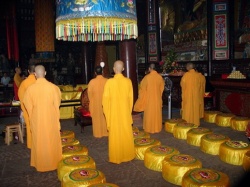Difference between revisions of "Kammam Sutta"
| Line 28: | Line 28: | ||
1. Woodward quotes SA [SN commentary] as correctly pointing out that "[[Eye]] in itself is not old but it has come about by former [[actions]] [i.e., [[kamma]].]" | 1. Woodward quotes SA [SN commentary] as correctly pointing out that "[[Eye]] in itself is not old but it has come about by former [[actions]] [i.e., [[kamma]].]" | ||
| − | 2. Cf. the classic [[definition]] of [[kamma]] at AN 6.63: cetanaaha.m [[bhikkhave]] kamma.m vadaami "[[Wikipedia:Volition (psychology)|volition]], [[monks]], I declare to be [[kamma]]" (see [[A.nguttara Nikaaya]]: An {{Wiki|Anthology}} translated by Nyaa.naponika [[Thera]], Part II [WH 208-211], p.67). | + | 2. Cf. the classic [[definition]] of [[kamma]] at AN 6.63: cetanaaha.m [[bhikkhave]] kamma.m vadaami "[[Wikipedia:Volition (psychology)|volition]], [[monks]], I declare to be [[kamma]]" (see [[A.nguttara Nikaaya]]: An {{Wiki|Anthology}} translated by [[Nyaa.naponika]] [[Thera]], Part II [WH 208-211], p.67). |
3. Vedaniiya.m. Hence a basis for [[craving]] etc. | 3. Vedaniiya.m. Hence a basis for [[craving]] etc. | ||
| Line 36: | Line 36: | ||
5. This is really the [[Third Noble Truth]]. | 5. This is really the [[Third Noble Truth]]. | ||
| − | 6. The [[word]] here is kammanta. [[Right Action]] is specifically the [[observance]] of the first [[three precepts]], i.e., abstaining from killing, theft and {{Wiki|sexual}} {{Wiki|misconduct}}. | + | 6. The [[word]] here is kammanta. [[Right Action]] is specifically the [[observance]] of the first [[three precepts]], i.e., abstaining from {{Wiki|killing}}, theft and {{Wiki|sexual}} {{Wiki|misconduct}}. |
| − | 7. Kammanirodha-gaaminii-pa.tipadaa. The usual term for the [[Path]] is dukkhanirodha-gaaminii-pa.tipadaa "the [[path]] (or practice) that leads to the [[extinction]] of [[suffering]]." Here the link between [[kamma]] and [[dukkha]] is clearly brought out. Those who have [[attained]] the goal do not create even good [[kamma]]. | + | 7. Kammanirodha-gaaminii-pa.tipadaa. The usual term for the [[Path]] is dukkhanirodha-gaaminii-pa.tipadaa "the [[path]] (or [[practice]]) that leads to the [[extinction]] of [[suffering]]." Here the link between [[kamma]] and [[dukkha]] is clearly brought out. Those who have [[attained]] the goal do not create even good [[kamma]]. |
{{R}} | {{R}} | ||
Revision as of 07:21, 9 March 2015
Kamma.m Sutta: Kamma
translated from the Pali by
Maurice O'Connell Walshe
"Monks, I will teach you about new kamma and old kamma, about the ceasing of kamma and the path that leads to the ceasing of kamma. Listen well, pay close attention and I will speak.
"The eye [[[Wikipedia:ear|ear]], nose tongue, body (touch), mind],[1] monks, is to be regarded as old kamma, brought into existence and created by volition,[2] forming a basis for feeling.[3] This, monks, is called 'old kamma.'
"And what, monks, is new kamma?
"The action[4] one performs now by body, speech and mind. This monks, is called 'new kamma.'
"When, monks, by ceasing actions of body, speech and mind, one touches liberation,[5] this, monks, is called 'the ceasing of kamma.'
"And what, monks, is the path that leads to the ceasing of kamma?
"It is the Noble Eightfold Path, namely Right View, Right Thought, Right Speech, Right Action,[6] Right Livelihood, Right Effort, Right Mindfulness, Right Concentration. This, monks, is called 'the path that leads to the ceasing of kamma.'[7]
"Whatever, monks, a teacher ought to do out of compassion, for the profit of his disciples, that I have done, having compassion for you.
"Here monks, are the roots of trees! Here are lonely places! Meditate monks. Do not be slothful, have no subsequent regrets. Thus we charge you."
Notes
1. Woodward quotes SA [SN commentary] as correctly pointing out that "Eye in itself is not old but it has come about by former actions [i.e., kamma.]"
2. Cf. the classic definition of kamma at AN 6.63: cetanaaha.m bhikkhave kamma.m vadaami "volition, monks, I declare to be kamma" (see A.nguttara Nikaaya: An Anthology translated by Nyaa.naponika Thera, Part II [WH 208-211], p.67).
3. Vedaniiya.m. Hence a basis for craving etc.
4. The same word kamma is used in the Pali.
5. This is really the Third Noble Truth.
6. The word here is kammanta. Right Action is specifically the observance of the first three precepts, i.e., abstaining from killing, theft and sexual misconduct.
7. Kammanirodha-gaaminii-pa.tipadaa. The usual term for the Path is dukkhanirodha-gaaminii-pa.tipadaa "the path (or practice) that leads to the extinction of suffering." Here the link between kamma and dukkha is clearly brought out. Those who have attained the goal do not create even good kamma.

